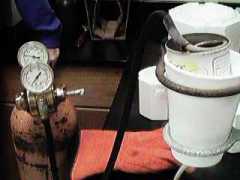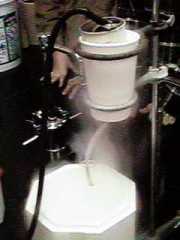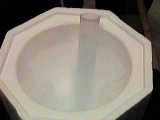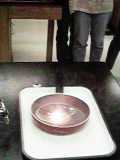The students love to see liquid oxygen. And why not, it is truly fascinating to see this
life-sustaining chemical when it is cold, wet, blue (!!!), and more combustion-supporting
than ever. To make condensed oxygen, I use three main components. First, I have a cylinder
of compressed, industrial-grade oxygen (197 cubic feet). Second, I have a 10 L Dewar flask
for liquid nitrogen. And last, I have a homemade condensor.
The condensor was made by finding an appropriately
sized can. An 8 ounce can with a tall, slender build will work. Mine is a Texas Pete
hotsauce can. You need to purchase some copper tubing from the hardware store with a
diameter of about 0.5 cm. This can be coiled by carefully wrapping it around a graduated
cylinder or a broom handle. Leave a straight section at the top and bottom. A hole must be
punched in the bottom of the can that allows the the tubing to pass through and extend
several inches below the can. The can has to hold liquid nitrogen so you must seal this
opening. I originally soldered the tubing to the can, but after contracting and expanding
due to extreme temperature changes, the solder came loose. My second attempt at sealing
the can involved pouring an epoxy resin mixture into the bottom. It has worked
beautifully, but I am sorry to say that I can't recall the exact type or brand. I have the
can in a ring clamp with a large stryofoam cup surrounding it to reduce heat transfer. Any
space in the cup can be filled with styrofoam "peanuts".
To make the LOX, the oxygen supply is connected to the
top of the copper coil using rubber tubing. Liquid nitrogen is added to the can to begin
cooling down the coils. This nitrogen will boil quickly until the heat is removed from
inside the can. Now top off the can with nitrogen and it will last surprisingly long. To
catch the LOX, I use half of a styrofoam packing container for concentrated acid and place
a large styrofoam cup inside with "peanuts" filling up the gaps. Make sure the
students notice that the peanuts are packed to the top of the container (they soon won't
be - a nice demonstration of gas behavior). A large test tube is placed in the cup and
placed so the bottom of the copper tubing is about 1/3 of the way down the tube. The cup
is filled with liquid nitrogen to allow us to maintain the LOX as it is produced.
The copper coils are now sufficiently devoid of kinetic
energy (boiling point of liquid nitrogen = -196 *C). The oxygen is now allowed to enter
the coils at a low rate. With a boiling point of -183 *C, the oxygen gas molecules
experience "sticky" collisions on their journey through the coils. The whole
set-up will be quite foggy now due to condensing water vapor so you will not be able to
see the oxygen dripping from the bottom of the condensor. However, you will start to
notice a blue tint in the bottom of your collection cup. It won't be long until the test
tube is full. Keep your LOX in liquid nitrogen if you are not going to use it right away.
There are a lot of interesting things that you can do
with LOX, but many of them are life-threatening. Extreme combustion and explosions are a
very real possibility if a combustible fuel is present. Keep in mind: liquid oxygen offers
almost 4000 times the level of oxygen found in the air (also remember that the atmosphere
around your boiling oxygen is becoming more concentrated). The key is to limit the
quantity of combustible fuel. You can dip a wooden splint in the test tube of LOX, take it
out, and light the end of it. The LOX does not soak into the wood well, but you will
observe a much faster rate of combustion. Beware of using materials that will soak up a
lot of LOX and offer a lot of potential energy. I've done personal experiments with
charcoal sticks and the degree of fireworks is hard to predict. A demonstration that
offers a great lesson in chemical reactions is to find two pans, one large and one small.
Pour some liquid nitrogen in the large pan and put the small pan in the nitrogen. Allow
the small pan to lose its heat and then add your LOX. Tell the students that you are going
to throw a match into this concentrated oxygen. The students will retreat in hopes of
avoiding the impending inferno. Most students believe that the oxygen will burn all by
itself. Have them write a combustion equation and think about limiting reactants. They
will soon realize that the match represents very little combustible fuel. However, the
match burns spectacularly when compared to a match burning in normal oxygen
concentrations. |
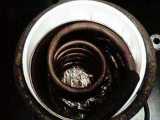
|

